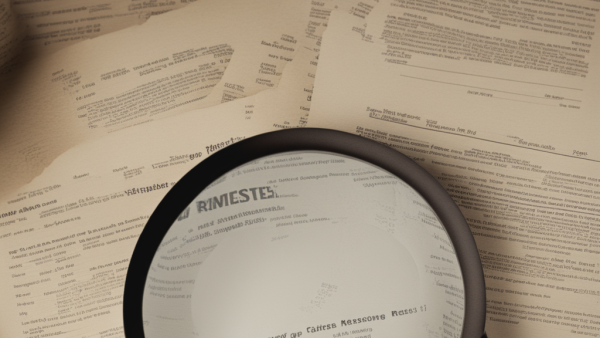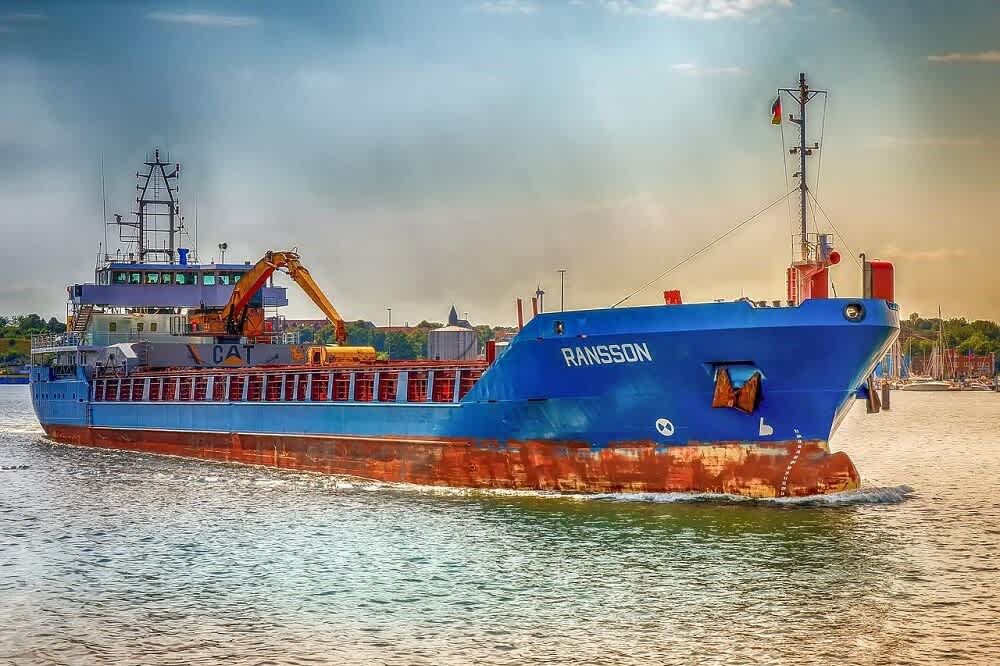
by Sam Franklin | August 08, 2022 | 19 min read
All you need to know about container shipping
Get fundedLast updated: September 02, 2022
A large number of goods we use every day, from food to medicines, smartphones, and furniture, often travel large distances across international borders to reach us. Rugs from India, ceramics from Turkey, or clothes and industrial goods from China (a staggering 90% of about 11 billion tons of goods transported annually) travel by sea. Almost 60% of these are shipped in large containers, whereas commodities like crude oil or grains are shipped directly inside the hull or the body of a vessel.
It isn’t a stretch to call container shipping the backbone of international trade. There is a precise science behind the timely and accurate transportation of cargo in containers across shipping routes around the world. If you are looking to import goods and want to know more about container shipping, you are in the right place. In this article, we explore the many facets of container shipping, including the various modes of container shipping, the variety of containers available for shipments, and more.
Table of contents
- What are shipping containers?
- Shipping container sizes
- What is a container ship?
- How is freight shipped in containers?
- How much does container shipping cost?
- Shipping container documentation
- What are the steps of container shipping?
Container shipping: Types and dimensions
What are shipping containers?
Shipping containers are large, strongly built metal boxes that are used to transport goods over long distances. Standardised or general purpose containers, widely used for shipping by rail, road, or sea, make transporting goods, stowing, and cargo handling easier. These have made the international shipping of goods more efficient and brought in economies of scale.
Types of shipping containers
There are various types, shapes, sizes, and dimensions of shipping containers available depending on the cargo you need to ship. Here we list some of the most commonly used containers to help you choose what works for your cargo:
1. Standard dry shipping containers
These are the most commonly used general-purpose containers for shipping by sea, road, or rail. Standard containers are made of strong steel or aluminium to protect your goods from water, humidity, wind, or any kind of damage. Standard dry shipping containers mainly come in these lengths: 20 ft, 40 ft, and 45 ft. These are usually about 8 feet (2.43m) wide and 8.5 feet (2.59m) high. Aluminium containers are wider and have a slightly larger payload (net cargo weight transported) than steel containers, whereas steel containers have a giant interior cube.
2. High cube containers
High cube containers are about a foot taller (about 2,896 mm or 9'6") compared to standard dry containers, making them good for products that need extra height. These are suitable for short-sea shipping and have the same loading capacity as trailers. High cube variations come in 20 ft, 40 ft, and 45 ft container lengths.
3. Open-top containers
Open-top containers are almost the same as standard dry containers, just without a roof. If your goods are large but not big enough for a high cube container and require a forklift for loading and unloading, you will need an open-top shipping container. These have a removable roof that makes the handling of goods easier. While in transit, open-top containers use a hard, removable steel roof or a tarpaulin to cover your products.
4. Flexitank containers
Flexitank containers are made for shipping non-hazardous liquids like water or cooking oil. A flexitank is a hermetically (airtight) sealed, collapsible bag that can be loaded with the liquid product and secured inside a standard container. A flexitank container can hold about 10,000 - 24,000 litres of liquid cargo. However, customised flexitank containers can hold up to 100,000 litres of product.
5. Reefer containers
Reefer or refrigerated containers are used for shipments that need temperature, humidity, and airflow control. These are equipped with a refrigeration unit which is connected to the power supply on a vessel or a truck. These maintain a stable temperature inside, have controlled humidity levels, and adequate airflow making them suitable for shipping chilled and frozen goods like dairy and meat products, frozen seafood like salmon and tuna, ice cream, and concentrates.
Need to ship frozen or chilled goods? Read more about reefer containers here.
6. Insulated containers
Insulated containers are often referred to as non-operational refrigerated containers. These are somewhere between a standard dry container and a refrigerated container in terms of functionality. Insulated or thermal containers have regulated temperature control, making them ideal for long-distance transportation of pharmaceutical products, fresh produce, or chemicals. To protect these products from contamination, insulated containers are equipped with a mechanical compressor to keep the air inside hot or cool, depending on what the cargo needs.
7. Special purpose containers
Special purpose containers are manufactured to ship special, often dangerous cargo such as weapons or explosive materials. These are customised using specific materials in order to make them safe and suitable for special types of cargo.
8. Flat rack containers
Flat-rack containers are akin to regular dry containers, except that they don't have two long side walls or a roof. These look like a rack with a strong and solid base. Flat rack containers are used to ship large, bulky items that won't fit properly inside standard containers. During shipping, these can be covered with heavy-duty tarpaulin to protect the goods.
Shipping container sizes
Shipping and storage containers come in a variety of sizes. Here are the standard dimensions for 8, 10, 20, and 40-foot units, including their external and internal length, width, and height. When choosing a container for your cargo, always check the internal height, width, and length for maximum space optimisation.
1. 8-foot (2.42m) standard container dimensions
Also known as mini cubes, these are the smallest containers available for shipping. In terms of size, they are comparable to an average garden shed.
M = metre; Cf = cubic foot; Lbs = pound; Kg = kilogram; m3 = cubic metre
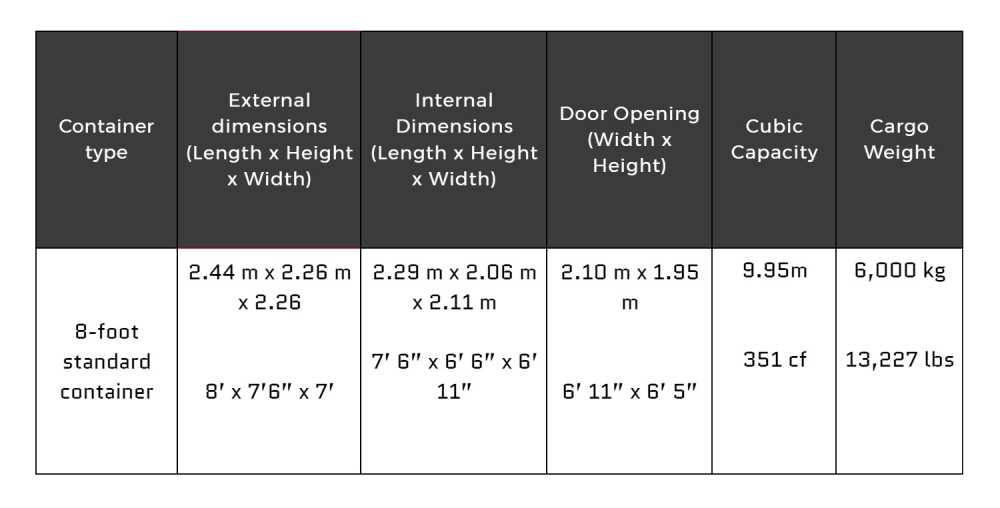
2. 10-foot (3.05m) standard container dimensions
These containers are not commonly used in commercial shipping but can be used for shipping overland. A 10-foot container can be used for secure cargo storage or for moving goods on trucks.

3. 20-foot standard container
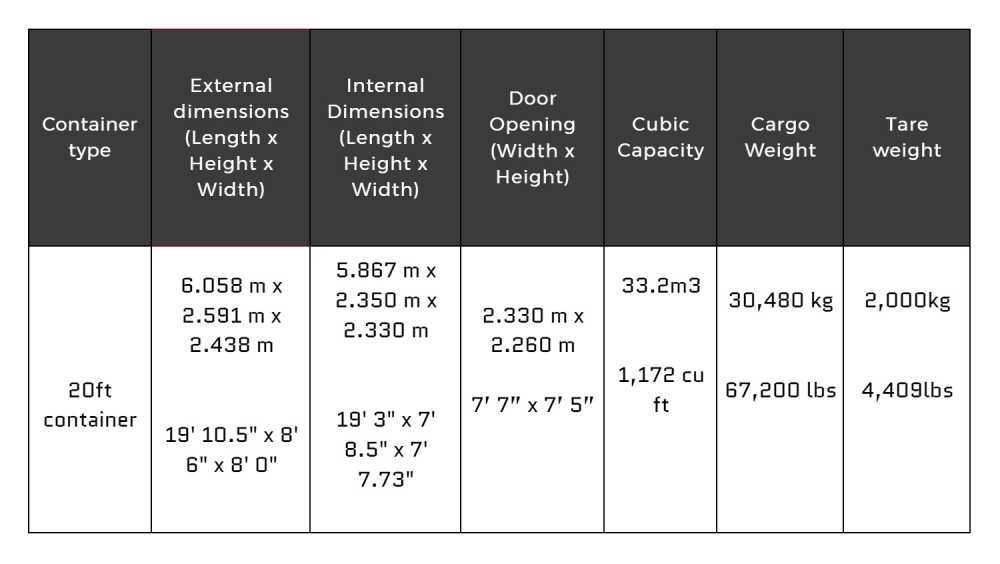
A 20-foot standard container, also referred to as the twenty-foot equivalent unit (TEU), can roughly hold the contents of a three-bedroom house, including things like a sofa, bed, TV, refrigerator, storage boxes, etc. These are easily stackable and relatively cheaper to ship. A 20-foot container can fit 10-11 pallets.
4. 40-foot standard container
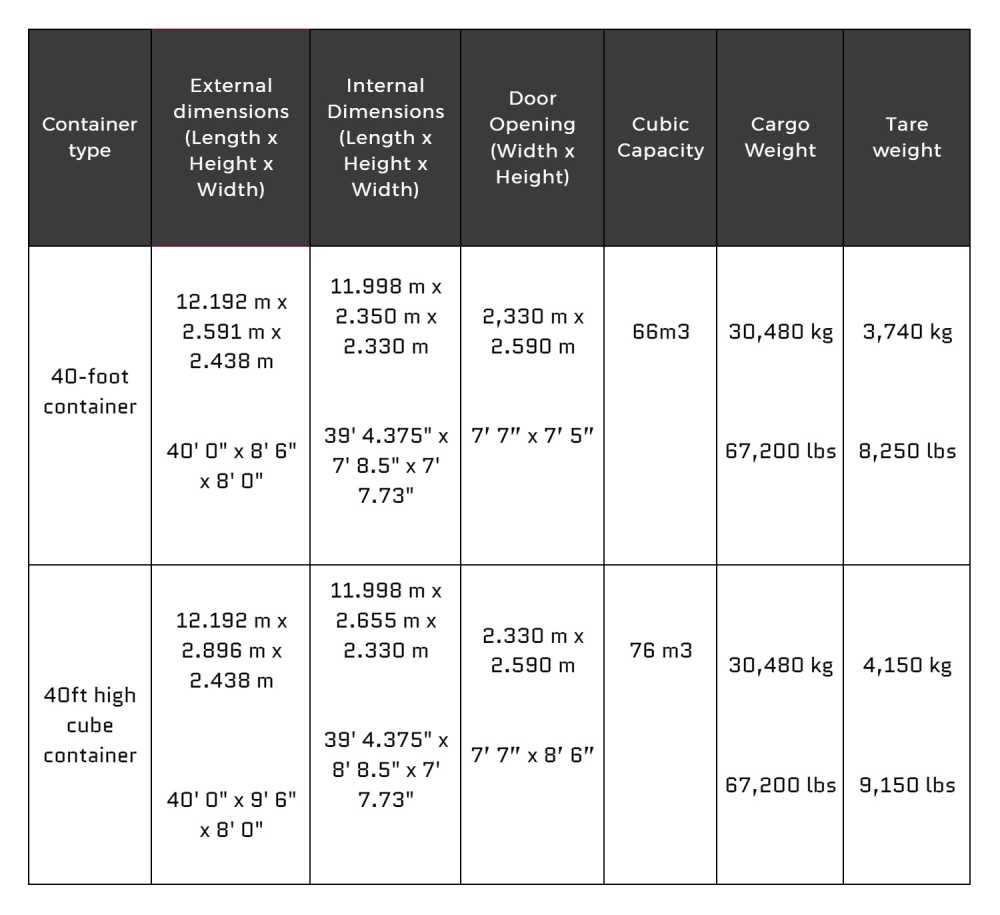
One of the most commonly used containers in ocean freight, 40-foot containers are mainly used for voluminous cargo like cotton, furniture, paper scrap, clothes, etc. A high cube 40-foot container, which can be up to 2.7 metres or 8.1 feet tall, is used for goods that need extra height. A 40-foot standard container can fit about 20-24 pallets.
Read more about container dimensions here.
Read more about Euro pallet dimensions here.
How many pallets fit into a container? Read here
What is a container ship?
Container ships are large vessels that are built to hold enormous quantities of cargo and carry them in different kinds of containers between ports around the world. This process of shipping cargo in different types of intermodal containers is called containerisation.
How is freight shipped in containers?
There are mainly three modes of transport for container shipping internationally and domestically. We are listing them here with their advantages and disadvantages:
Sea freight
Sea freight is the most common mode of transportation of goods internationally. It is used for shipping a range of goods, from crude oil, raw materials, and industrial equipment, to cars, fruits, dairy, meat, apparel, and others. Goods are carried on huge container ships that can carry anywhere between 10,000 and 21,000 TEUs (twenty-foot equivalent units). There are container ships that are even larger. HMM Algeciras, for example, built by South Korea’s Daewoo Shipbuilding & Marine Engineering for logistics company HMM, has a capacity of 23,964 TEU. MSC Gülsün, built by South Korea’s Samsung Heavy Industries, can carry 23,756 TEU. If you have a shipment of significant weight and volume, sea freight is your best bet.
Advantages
Sea freight is an affordable means of transport over long distances
It is a comparatively sustainable means of shipping goods internationally
It is ideal for big volumes
Disadvantages
It takes longer compared to air, road, and rail freight
LCL & FCL shipping
There are mainly two modes of container shipment:
Full Container Load
Full Container Load or FCL is when a shipper uses the whole container for the transportation of their cargo exclusively and pays for the entire cost of transporting it. This is common amongst large companies that don't have to share container space with other shippers.
Less than Container Load (LCL)
LCL shipping includes consolidation of multiple shipments into one shared container. This works for businesses that have smaller consignments and want to pay only for the volume of space they use in a container.
Air freight
Air freight works best for a small volume of goods that need to be shipped quickly. This is also a good option for more valuable goods and express shipments. Air freight can be used for documents, consumer goods, textiles, fashion garments, etc.
Air freight uses unit load devices (ULD), which are either pallets or containers, to transport cargo. ULD pallets are aluminium plates that can fit into the cargo hold and be locked into place. The cargo on these palettes is secured with nets. ULD containers, made of aluminium or a combination of aluminium and plastic, are closed boxes used for air cargo.
Advantages
Air freight is a fast and secure way of transporting high-value goods
Highly reliable in terms of time and speed
Disadvantages
More expensive compared to rail, road, or sea freight
It is less sustainable compared to sea freight
Road freight
Road freight involves the movement of goods internationally or domestically using motor vehicles, mainly trucks. Even when you are moving your goods by sea, they usually cover the distance to and from the port by truck or rail.
Advantages
It's a door-to-door service
It’s relatively cheaper
It’s more flexible - it can easily accommodate schedule or route changes unlike rail, sea, or ocean freight
Disadvantages
Prone to traffic delays and high toll charges in certain countries
It can take a very long time over long distances
Rail freight
Rail freight is the usage of railroads for the transportation of cargo domestically and internationally. It is suitable for carrying bulky cargo over long distances.
Advantages
It's a cheaper means of shipping cargo over longer distances
It is safe, and the chances of breakdowns are low
Disadvantages
It is only available for places with rail connectivity
It isn’t suitable for short distances or small loads
Still have questions about freight shipping? Click herefor more detailed information.
How much does container shipping cost?
There are a variety of factors that impact the cost of FCL and LCL container shipping. In addition to the distance covered, the prices also depend on fuel costs, the route, and container size. Container shipping costs are subject to fluctuations. In 2021, for example, pandemic related supply chain disruptions, delays at ports and inland distribution networks caused a huge spike in shipping rates. Here are the factors that you should be aware of that impact shipping costs:
1. Route
Certain sea routes are busier compared to others. Shipping on busier routes is generally more expensive compared to less common routes.
2. Seasonality
Shipping rates usually go up before the holiday season in the U.S. and Europe in December and the Chinese New year in January. This means that the months leading up to the holiday season, October and November, are a busy time for shippers and container shipping prices go up.
3. Fuel prices
Fuel prices are constantly fluctuating and these impact freight charges. To counter the impact of fuel prices, shipping lines apply a bunker adjustment factor (BAF). It is an additional surcharge that is levied to account for the effect of oil price fluctuations on carrier costs.
The other factors that influence freight charges are the volume of shipment, currency fluctuations, container type, and terminal handling charges.
Cost of shipping a container overseas
Shipping rates are still high compared to pre-pandemic, but they havefallen from their peak since last year.
How are container shipping costs calculated?
If you are looking to import goods to the UK, here's a brief insight into how ocean freight charges are calculated:
Shipping companies have base rates that are used to calculate ocean freight charges. The freight rates are based on the size of the container that you use - 20-foot, 40-foot, 45-foot, high cube, reefer, or non-refrigerated.
LCL shipment
LCL shipments are charged depending on the weight or the volume, whichever of the two is greater. The greater of the two is referred to as the chargeable weight. To calculate the freight rate, the weight of the shipment (in tons) or volume (in cubic metres (CBM)) is multiplied by an LCL base rate. CBM is the freight volume of the shipment, which is calculated by multiplying its width, height and length. It is also called the volumetric weight or the space occupied by the cargo inside the container.
The gross dimensions of the consignment include the packaging and palletisation. If the weight of the cargo is more than a ton, then the exact weight is used to calculate the freight rate.
FCL freight rates
FCL shipping includes the following charges:
Freight: Freight price is the price of transporting a container between two ports. It may include a fuel surcharge and currency fluctuations, but sometimes they are charged separately.
BAF: As mentioned earlier, this is an additional surcharge levied to compensate for fuel price fluctuations.
Currency Adjustment Factor (CAF): CAF is a surcharge levied to compensate for currency fluctuations.
Equipment Imbalance Surcharge (EIS): An EIS may be levied if a shipment is going to an unusual destination and the shipper has to return empty.
Port-related expenses are also factored into freight charges:
Terminal Handling Charge: This is the cost of loading or unloading containers and other handling charges.
Port charges: Port charges are essentially entry and exit fees for goods at ports.
Here are some approximate costs of shipping a container to the UK:
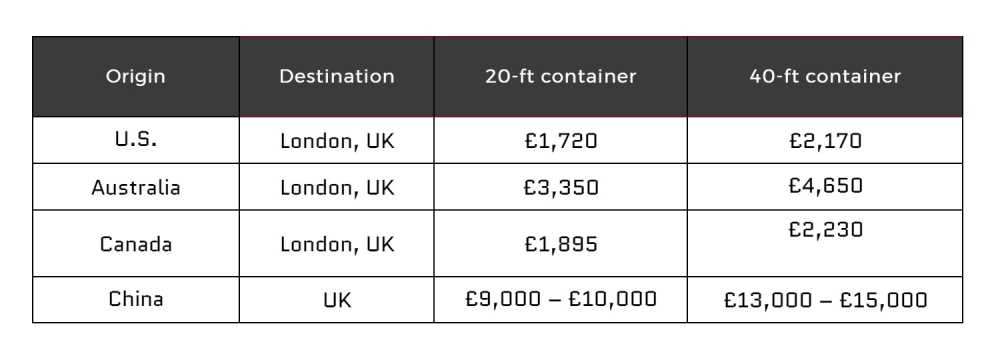
Choosing between sea and air freight
Sea freight and air freight have their own respective advantages and disadvantages, and they are both suited for different kinds of products. If you are finding it hard to choose between the two of them, here are a few points to consider that will help you make a decision.
Cost and speed
Cost is a big factor for business when they choose between ocean and air freight. Ocean freight is cheaper and offers more capacity compared to air freight. The cost of international shipping by air can be four to five times more expensive compared to ocean freight. But shipping your goods by air is the faster option.
For example, shipping your goods between China and the UK by sea may take about 25-60 days, but it will only take about 4-15 days by air freight. These timelines are dependent on the city/port or airport of origin and the final destination. One thing to remember here is that sometimes air freight can be a cheaper option for smaller packages compared to LCL shipping. If you have a small volume of goods, you should always get a quote for both air and sea freight.
In terms of time, sea freight may also have unexpected hold-ups due to weather conditions, delays at ports, or customs clearance.
Type of goods
The second thing to consider while choosing between air and sea freight is the type of cargo. Sea freight is suitable for all kinds of regular, bulky, or oddly shaped cargo. Air freight, on the other hand, is more restrictive in terms of size, volume, and weight. There is also a long list of items that are prohibited from being shipped by air. These include:
Explosives, including fireworks
Gases such as gas lighters, dry ice, compressed gas, or fire extinguishers
Flammables
Corrosive substances like batteries
Toxic and infectious items like pesticides and insecticides
Biological products and waste
Items that are deemed dangerous to public health
Shipping container documentation
International shipping means that you need to have your documentation in order for seamless transit between ports and countries. Lack of necessary documents can result in delays and additional costs. Here is a list of the most important documents you should have if you are shipping goods overseas or importing them.
1. Bill of lading
Also called B/L, the bill of lading is a legal document that is issued by the carrier to a shipper as an acknowledgement of the receipt of cargo for shipment on a vessel. It details the type of goods, their quantity, and the final destination. It has to be signed by an authorised representative from the carrier, shipper, and receiver.
Learn more about bills of lading
2. Packing list
A packing list accurately documents the details of the shipment, down to the weight, value, and volume of the cargo and each box that is being shipped. This is meant for freight forwarders, shippers, importers, as well as the customs office if they want to verify the contents of the shipment. This is helpful in case of an inspection by customs officials.
3. Commercial invoice
A commercial invoice is a proof of the sale of goods. It includes all the freight shipment details, including the importer, exporter, freight forwarder, and banks.
4. Certificate of origin
The certificate of origin is a trade document detailing where the goods being shipped were made. The certificate of origin is prepared by the manufacturer or the importer and certified by a government authority. It is needed at the customs office for clearance together with the other documents.
5. Letter of credit
A letter of credit is a promise in the form of a document, issued by a bank on behalf of the buyer. It guarantees that a payment from the buyer will be made to the seller once the conditions of the letter of credit are met.
6. Shipper’s Letter of Instruction (SLI)
This document details shipping instructions to the freight forwarder for the seamless movement of the goods across international borders. The SLI may also include details on billing terms and other charges.
Apart from these, you will also need your marine insurance documents handy. To learn more check out our article about customs clearance documents and procedures.
What are the steps of container shipping?
The steps of container shipping can sound intimidating, especially if you are new to it. Various parties are involved, including the supplier, importer, freight forwarders, customs officials and others. There is also a list of clearances and documentation. We have tried to simplify the process for you here:
1. Placing the order
The first step is when an importer or a consignee places an order with a supplier/manufacturer or a consignor. The importer gets a quote or a proforma invoice (preliminary bill of sale) from the supplier, providing an estimate of the total cost of goods. After the quote is approved, a purchase order is created; this details the order and the total cost of goods. It can also include other details like the destination address, freight dimensions, etc.
2. Shipping incoterms
The contract between the buyer and the supplier is governed by incoterms, which allocate costs and risks between the two parties. Incoterms determine whether the buyer or the supplier will engage a freight forwarder for each stage of the international shipping process.
3. Finding and engaging a freight forwarder
Once the purchase order is placed and incoterms are selected, a freight forwarder is engaged to organise the transportation of goods from the origin to the destination country. A freight forwarder is an individual or a company that coordinates and arranges the shipment of goods by using single or multiple carriers across land, sea, rail, or air. The forwarder will arrange containers that will be used to transport the products.
4. Obtaining documentation for shipping
Once the order is placed, the supplier obtains a letter of credit and issues an order of confirmation and a commercial invoice to the importer.
5. Organising the export of goods
If the freight forwarder is working independently, they organise the collection of goods by an overseas partner. The freight forwarder or the overseas partner will then organise the export of goods. This will require key documents to be prepared. These are the packing list, certificate of origin, a shipper’s letter of instruction (SLI), and a manufacturer's letter of declaration, which details whether the goods are toxic or hazardous.
6. Dispatching goods to the port The goods are packed into containers and transported to the port. At the port, they undergo an export clearance. Before the shipper picks up the goods, the bill of lading is issued. The goods are then processed through export customs clearance, where all the documentation is reviewed. After this, containers are placed on vessels for international transit. The vessel carries the shipment from the origin to the destination port. The shipper provides documentation and data about the cargo to the destination country. Once the vessel arrives at the destination port, the cargo containers are unloaded using large cranes.
Learn all about the most important UK ports
7. Arrival
On arrival at the country of destination, goods have to go through customs. Depending on the type of goods, customs fees and import duties are levied on them. They may also be subject to inspection if the customs office needs to. Certain goods may be subject to quarantine depending on the rules in the destination country.
8. Shipping from port to buyer
After the customs clearance, containers are loaded onto a special truck trailer or a train for their journey to a distribution centre or an agreed-upon place for the buyer to receive the shipment. If the goods are sent to a distribution centre, the container is opened and individual packages are prepared for shipment to the buyer.
Also check out our guides to shipping goods from China to the UK and importing from Turkey.
Written by

Sam founded his first startup back in 2010 and has since been building startups in the Content Marketing, SEO, eCommerce and SaaS verticals. Sam is a generalist with deep knowledge of lead generation and scaling acquisition and sales.


